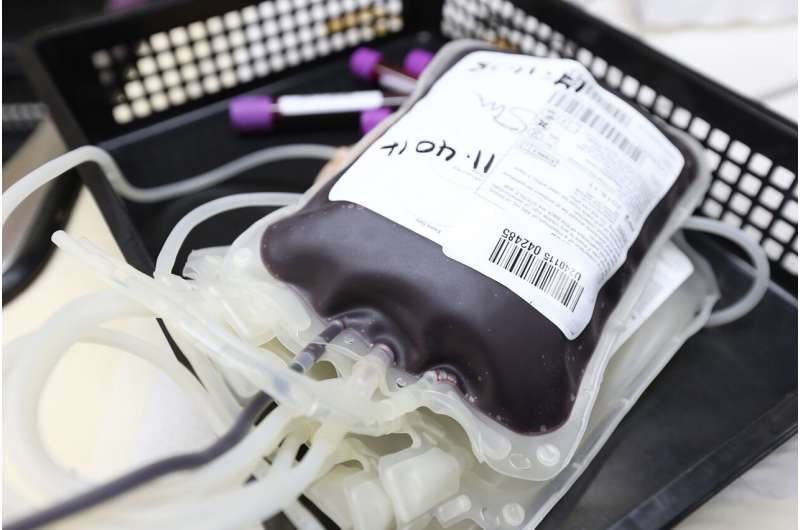This article has been reviewed according to Science X's editorial process and policies. Editors have highlighted the following attributes while ensuring the content's credibility:
fact-checked
peer-reviewed publication
trusted source
proofread
Research shows that the bottom has been reached in restrictive blood transfusion policy

The trend in hospitals and guidelines is to be increasingly cautious with blood transfusions. Due to side effects associated with blood transfusion and the increasing scarcity and costs of blood products. For example, in recent years the number of patients receiving a transfusion during their ICU admission has halved.
Researchers from Amsterdam UMC, in collaboration with eight other Dutch hospitals, have shown that being increasingly restrictive in preventive blood transfusion is not, in all cases, understandable. The results of this study are published today in the New England Journal of Medicine.
The research led by Amsterdam UMC is a collaboration between critical care doctors and hematologists, both of whom are often confronted with issues related to blood transfusion. One of these issues was the focus of the research.
"In the ICU, more than half of patients receive a central venous catheter (CVC) for the administration of medication or for dialysis. But what do you do when patients need a CVC and they have a shortage of platelets, which causes clotting problems and increases the tendency to bleed," says lead researcher and head of Amsterdam UMC's Intensive Care Unit Alexander Vlaar.
Unexpected outcome
To prevent possible bleeding, the answer used to be a preventative platelet transfusion. In recent years, however, the question has been increasingly asked in health care whether a platelet transfusion is necessary to be able to insert a catheter safely. The limit for which has also been halved in the past ten years, according to transfusion guidelines.
"We therefore entered this study with the expectation that, just as in other situations for which this was already known, we could safely omit a platelet transfusion altogether. But the outcome was different. Patients with very few platelets actually have less bleeding if they are transfused prior to CVC placement," adds Vlaar.
Staying critical
It is the view of the researchers that the outcomes of this study do not mean that all patients will have to undergo a transfusion from now on as a precaution, but it does show that any possible cost savings should always be properly investigated.
"If we had not further investigated this internationally implemented policy, doctors would simply follow this policy from the transfusion guidelines. But we must remain critical on this point and, as doctors, continue to ask ourselves what risk we consider acceptable in cost reduction. In this study we show that we have to administer a transfusion on average 14 times to prevent bleeding once. So, the question is what the prevention of bleeding is worth. That is really a consideration that will have to be made every time," says medical researcher Floor van Baarle.
A CVC is also often used in the treatment of hematology patients, but patients with hematological disorders have a completely different cause of the low platelet count than patients in the Intensive Care Unit.
"In hematology patients, the production of platelets is disrupted by the disease or by chemotherapy, while most ICU patients do produce platelets, but they are immediately consumed. Our study shows that placing a CVL without a preventative platelet transfusion as a precaution leads to more bleeding in hematological patients than in ICU patients," says lead researcher and hematologist Bart Biemond.
"The great thing about this research project is the joint effort of two different disciplines, with hematological and ICU patients and doctors. In this study, we show that the cost-benefit assessment can work out differently for different patients and that is very valuable information."
More information: Prophylactic platelet transfusion prior to central venous catheter placement in patients with severe thrombocytopenia: a multicenter randomized controlled trial, New England Journal of Medicine (2023).





















